Droop Snoot Group
HPF - Firenza - Magnum - Sportshatch - HS - HSR
RAK 2 - Opel's contribution to the Space Race
One of the more interesting - not to say positively scary - exhibits at Billing in 2006 was a replica of the 1928 Opel rocket car, RAK 2; tiny drum brakes, wire wheels, no harnesses - and 24 rocket tubes giving a possible 1320 lb thrust! The car was one of a series of rocket powered vehicles built by Opel, the result of a surge of interest in rocketry in '20s Germany and the brainchild of Austrian science writer Max Valier.
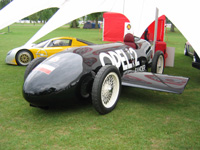
The RAK 2 replica at Billing
Valier was interested in astronomy when young, studied physics at Vienna University and was involved in aeronautics during the Great War. In the early 1920s he was gripped by the ideas of Hermann Oberth, a pioneer of modern rocketry. He wrote a book (reprinted six times) explaining Oberth's ideas in layman's language, and in 1927 helped to set up the 'Verein für Raumschiffahrt' (Spaceflight Society); an amateur rocketry club which brought together many of those who later made space flight a reality, including Oberth himself and Wernher von Braun.
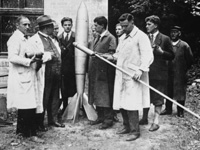
The Verein für Raumschiffart, 1930
He set out a four step plan to advance rocketry, starting with test bed experiments, progressing to rocket propelled vehicles and aircraft, and finally increasing the performance of the aircraft to the point where space flight was possible.
Valier approached Fritz von Opel, grandson of Adam Opel and head of Opel's publicity and research departments, for help. 'Rocket Fritz' was already using racing and speed trials to promote the company image and was interested in rocketry, so when the two met in autumn 1927 he can't have been difficult to persuade. The pair contacted Friedrich Sander, a well-known maker of black powder rockets, and the team was born.
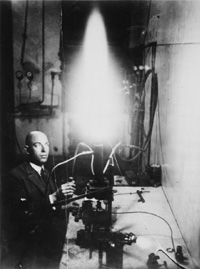
Max Valier at a test bench
The first trials began in March 1928, using an Opel road car with just two rockets fitted. Initially von Opel wanted to drive the car himself, but was persuaded not to in case of an accident. Driven by Kurt Volkhart, an Opel test driver, the car travelled 500 feet at 3 mph - hardly earth shattering, but enough to persuade the team that it was worth continuing.
After two further tests, they built a new vehicle from one of the Opel works race cars. The engine and box were removed to reduce weight, and a small wing stub fitted behind each front wheel to generate downforce at high speed. The car was fitted with twelve black powder rockets in two banks, ignited electrically by a switch fitted to the accelerator pedal. The first bank were fast burning to accelerate the car, the second bank slower burning to keep it moving. The car was christened RAK 1; RAK short for rakete, the German for rocket.
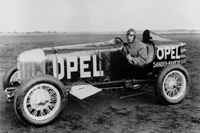
Kurt Volkhart in RAK 1
RAK 1 first appeared at Opel's test track at Russelsheim on April 11, 1928, in full view of the German press. Volkhart pressed the firing pedal once, then again; only seven of the rockets fired, but they accelerated the car to 62 mph in eight seconds. Buoyed by its performance (and the resulting publicity), the group immediately made plans to build a new, purpose built rocket car, RAK 2, based on an 80 series Opel in a streamlined body which predicted the shape of later racing cars.
The stub wings were used again, much larger this time and attached to a lever in the cockpit that enabled the driver to change the angle of attack. 24 rocket tubes were fitted, each giving 55 lbs thrust - a total of 264 lbs of explosives, enough to demolish a house. The tubes were wired separately to a firing pedal so that they could be ignited one by one.
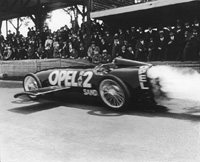
RAK 2 thrills the crowds
On May 23, 1928, the group took RAK 2 to the Avusring near Berlin. In front of 2000 spectators, the world's press, politicians and celebrities Fritz von Opel himself took the wheel. Pressing the firing pedal eight times, he accelerated to a record-breaking 148 mph in just over a mile. By that time Fritz was struggling to keep control, and when the front end started to lift dangerously he shut the car down, pulling up to applause from the crowd - and a kiss from actress Lillian Harvey.
Although it's been suggested Opel were only in it for the publicity, the group had always made it clear that rocket cars were just a first step. In a short speech after the run von Opel said "We also want to investigate the effect of acceleration on the human body - the final stage in our project will be to produce manned rocket propelled space ships". The publicity from the event more than repaid every pfennig that Opel had invested, and gave a significant boost to the then fledgling science of rocketry.
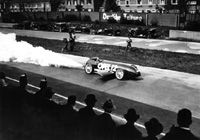
RAK 2 at speed at the Avusring
Further rocket car experiments followed. In June 1928 RAK 3, a rail mounted car with 10 rockets, set a new record for rail mounted vehicles at 158 mph watched by 20,000 spectators, before being destroyed on its second run. In the summer of 1928, RAK 4 - another rail car - was wrecked when a rocket exploded on ignition, setting off all the other rockets and making the car jump the rails. The railway authorities banned further tests, but by then the group had moved on, buying a glider christened Ente (duck), which they fitted with two 44 lb thrust rockets.
On June 11 1928 Ente flew just under a mile under rocket power, although on its second flight a rocket exploded, damaging the wing and setting the plane alight. Undeterred, von Opel commissioned Julius Hatry, a well-known glider builder, to make a bespoke rocket powered craft, the Opel - Sander - Hatry RAK 1. On June 30, 1929, RAK 1 flew two miles in 75 seconds, reaching 90 mph, before being destroyed in a crash landing.
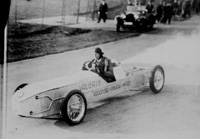
Valier tests RAK 6
That was the last time Fritz von Opel piloted a rocket-propelled vehicle, and soon afterwards the group separated, almost certainly as a result of changes at Opel. Perhaps realising what was soon to happen in Germany, the von Opels sold the company to General Motors later in 1929. Max Valier continued to experiment with rockets, moving from black powder to liquid fuel motors; he built two further cars, but was killed when a liquid fuel motor exploded on a test bed in 1930. Sander was twice arrested by the Nazis, who coveted his rocketry interests, and died in prison in 1938. 'Rocket Fritz' moved to Switzerland after the sale to GM; he lived until 1971, long enough to see the first manned landing on the Moon.
One final aside - in 1956, at the Nurburgring, the works Porsche 550s were outpaced by a production Spyder driven by Michel May. The Spyder carried an inverted wing to generate downforce, adjusted by a lever in the cockpit. May is now credited as the first man to improve cornering by using downforce; he fitted that wing on his Spyder because he'd remembered the wings on RAK 2.
Photographs by courtesy of Adam Opel A.G. and the V.B.O.A.
